UV protection for your eyes and
the delicate tissue around them is quite important for maintaining eye health
and vision. While we all know not to spend too much time in the sun without
sunscreen for our skin, sometimes we overlook the precautions needed to protect
our eyes from the harmful effects of UV from the sun. Especially during summer months when we spend a great deal of
time outdoors-walking, hiking, swimming-going to the beach-and just enjoying
our community, we need to be reminded to use proper UV eye protection.
UV
Protection & Eye Health
Ultraviolet light (UV) can cause
significant damage to eye health and vision. Exposure to UV has been
linked to many eye problems and in some instances is thought to quicken the
onset of eye diseases such as cataract, age related macular degeneration (AMD),
certain cancers on the delicate skin around the eye, Pterygia-a growth of white
tissue on the surface of the eye-and even Photokeratitis, a type of sunburn of
the cornea.
There are common sense precautions one can take to
avoid UV damage:
- Always wear sunglasses that block 100% of UVA and UVB rays. Sunglasses without UV protection may shade the eyes but actually cause the pupils to dilate, allowing in even more harmful rays.
- Wear a brimmed hat along with sunglasses that block 100% of UVA and UVB rays.
- Choose wrap-around sunglasses to protect the eyes and the skin around the eyes.
- Be aware that although some contact lenses may offer UV protection, they cannot protect the entire eye and the skin around it.
- Choose sunglasses made of unbreakable polycarbonate, especially for children and for those who lead active lifestyles.
- Be sure to ask your doctor about the photosensitizing side effects of any medications that you might take.
- Always wear eye protection when using a tanning bed. According the American Academy of Ophthalmology, tanning beds can produce UV levels up to 100 times more than the sun, which can cause serious damage to the external and internal structures of the eye and eyelids.
Today we have wide range of UV protecting eyeglass lenses available to choose from. Eye protection from UV needs to be complete but doesn’t have to be overly expensive. High quality sunglasses should block out 99-100 percent of both UV-A and UV-B radiation. It is also important to have UV protection in everyday eyewear, which is readily available with a number of UV blocking eyeglass lens materials, specialized coatings and photochromic lenses.
Patients visiting Northwest Indiana Eye & Laser Center can speak with our staff who will be able to provide the proper counseling and fitting of UV protecting lenses and eyewear. These eye care professionals can offer a wide variety of UV blocking lenses, coatings and color changing lenses to keep you safe.
If you or someone you know has a question or concerns about ultraviolet (UV) eye damage and injury and how to select protective eyewear please feel free to call Northwest Indiana Eye & Laser Center at 219-464-8223, or visit Northwest Indiana Eye & Laser Center or facebook.com/nwindianaeyeandlaser.
Northwest Indiana Eye & Laser
Center offices are located at 522 Marquette Street, Valparaiso, Indiana 46383
and 1001 South Edgewood Drive, Knox, Indiana 46354.
